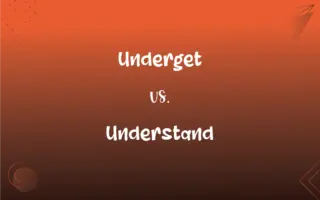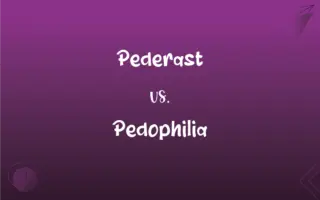Grin vs. Smile: What's the Difference?
Edited by Janet White || By Harlon Moss || Updated on November 7, 2023
A grin is a broad, often toothy expression of amusement, while a smile is a gentle, warm expression of happiness or approval.

Key Differences
A grin typically conveys a stronger emotion of amusement or cheekiness, often showing teeth, and can be less about warmth and more about personal satisfaction or a humorous response. A smile, on the other hand, is universally recognized as an expression of happiness, friendliness, or pleasure. It can be reserved or broad but is usually warm and positive. Grinning can sometimes be seen as mocking or sardonic, depending on the context, whereas smiling is almost always taken as a positive gesture.
In contrasting the two, a grin may not reach the eyes, giving it a mischievous or potentially insincere quality. A smile, conversely, often involves the muscles around the eyes, indicating a genuine emotion. When one grins, it can be a reaction to a particular situation or joke, while a smile can be a polite response or a spontaneous expression of joy.
In terms of social perception, a grin can sometimes be perceived as less formal or professional than a smile. A smile is often encouraged as a friendly gesture in many social and professional settings. Meanwhile, a grin might be seen as inappropriate in serious situations.
Furthermore, the act of grinning is sometimes associated with an internal joke or thought, implying a private amusement. Smiling, however, is generally more communicative and is used to convey goodwill or sociability to others.
In literature and art, grins are often attributed to characters with a mischievous or secretive streak, such as the Cheshire Cat's famous grin. Smiles are more universally attributed to characters that are meant to be sympathetic, approachable, or kind-hearted.
ADVERTISEMENT
Comparison Chart
Expression Intensity
Broad, toothy
Gentle, subtle
Emotion Conveyed
Amusement, cheekiness
Happiness, warmth
Social Appropriateness
Less formal, can be mocking
Universally positive, polite
Physical Involvement
May involve only the mouth
Often involves eyes and mouth
Perceived Sincerity
Can be insincere or sardonic
Generally perceived as genuine
ADVERTISEMENT
Grin and Smile Definitions
Grin
A grin is a wide smile without sound.
She gave a silent grin when she saw the surprise party.
Smile
A smile is a facial expression formed by flexing the muscles near both ends of the mouth.
Her smile lit up the room as she entered.
Grin
A grin often shows teeth and may indicate amusement or sarcasm.
The comedian's joke made him grin from ear to ear.
Smile
A smile often expresses happiness, pleasure, or affection.
They exchanged smiles across the crowded room.
Grin
A grin may also be involuntary, revealing inner thoughts or feelings.
His grin betrayed his true feelings about the announcement.
Smile
To smile is to convey friendliness or approval.
He smiled to show he agreed with the decision.
Grin
To grin is to express mischief or self-satisfaction.
He grinned mischievously as he hid the toy.
Smile
A smile may serve as a comforting gesture.
The teacher's smile reassured the nervous student.
Grin
A grin can be a facial expression of irony or disbelief.
She couldn't help but grin at the absurdity of the situation.
Smile
A smile can be a polite reaction to social interactions.
She smiled warmly at the new neighbor's greeting.
Grin
To smile broadly, often baring the teeth, as in amusement, glee, embarrassment, or other strong emotion.
Smile
A facial expression characterized by an upward curving of the corners of the mouth and indicating pleasure, amusement, or derision.
Grin
To express with a grin
I grinned my approval.
Smile
To have or form a smile.
FAQs
When do people usually grin?
People often grin in response to humor, when they are feeling mischievous, or when they are privately amused.
Is grinning considered less polite than smiling?
Grinning can be seen as less formal and sometimes inappropriate, depending on the context.
Do cultural differences affect how grins and smiles are perceived?
Yes, cultural norms can influence the interpretation and social acceptability of grins and smiles.
Can a grin be friendly?
While often mischievous, grins can also be friendly, especially among friends sharing a joke.
Are smiles always happy?
Smiles can express a range of positive emotions, not just happiness.
What does a smile generally indicate?
A smile usually indicates happiness, approval, or a friendly disposition.
Do animals grin?
Some animals appear to grin, but this is often a misinterpretation of their facial expressions by humans.
What is a grin?
A grin is a broad, often toothy expression typically associated with amusement or cheekiness.
Can a smile be insincere?
While a smile is generally perceived as genuine, it can be insincere, such as when used to hide one's true feelings.
Is it possible to tell the difference between a grin and a smile?
Yes, by the expression's intensity and whether the eyes are involved; grins are broader and may not involve the eyes.
Can grinning be a sign of aggression?
In some contexts and cultures, showing teeth in a grin can be interpreted as a sign of aggression.
Can someone smile without being happy?
Yes, people can smile as a polite gesture or to mask their true feelings.
Can grinning or smiling be therapeutic?
Both grinning and smiling can have therapeutic effects, such as improving mood and encouraging positive interactions.
Are there professional situations where grinning is preferred over smiling?
Professional situations typically prefer smiling, as grinning can be seen as less formal or serious.
What is a "smirk" and how does it differ from a grin or smile?
A smirk is a half-smile that can indicate smugness or sarcasm, differing from a grin's openness and a smile's warmth.
How do grins and smiles affect social interactions?
Grins and smiles positively affect social interactions by conveying friendliness and openness, facilitating communication.
What facial muscles are used to grin?
Grinning primarily uses the muscles around the mouth, especially the risorius muscle which stretches the lips sideways.
What is a Duchenne smile?
A Duchenne smile is a genuine smile that involves both the mouth and the eyes.
How does smiling affect mood?
Smiling can improve mood and reduce stress by triggering the release of certain neurotransmitters.
Is it possible to differentiate a genuine smile from a fake one?
Yes, genuine smiles typically involve the eyes (Duchenne smiles), whereas fake smiles might only use the mouth.
Is a smile universal?
Smiling is a universal expression for happiness and friendliness across all cultures.
Why might someone grin inappropriately?
Inappropriate grinning may occur due to nervousness, discomfort, or a misreading of social cues.
Is it common to grin when nervous?
Some people might grin when nervous, although it's more common to smile in an attempt to appear friendly or at ease.
How do children learn to smile?
Children learn to smile from watching the facial expressions of those around them, and it is also a natural expression that appears early in infancy.
Does smiling have health benefits?
Smiling can lower heart rate, reduce stress, and release endorphins, providing health benefits.
About Author
Written by
Harlon MossHarlon is a seasoned quality moderator and accomplished content writer for Difference Wiki. An alumnus of the prestigious University of California, he earned his degree in Computer Science. Leveraging his academic background, Harlon brings a meticulous and informed perspective to his work, ensuring content accuracy and excellence.
Edited by
Janet WhiteJanet White has been an esteemed writer and blogger for Difference Wiki. Holding a Master's degree in Science and Medical Journalism from the prestigious Boston University, she has consistently demonstrated her expertise and passion for her field. When she's not immersed in her work, Janet relishes her time exercising, delving into a good book, and cherishing moments with friends and family.































































